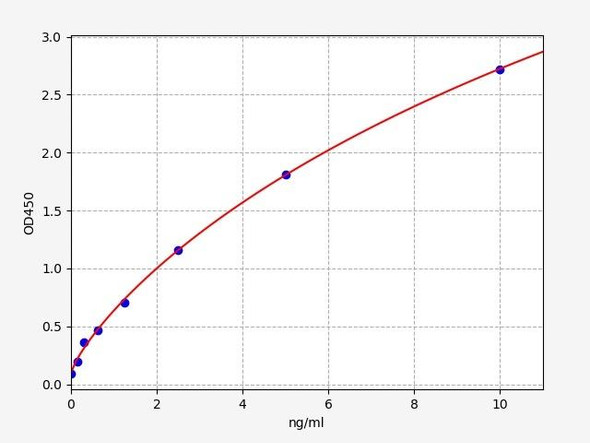Rat Signaling ELISA Kits 1
Rat TNF receptor-associated factor 6 (Traf6) ELISA Kit
- SKU:
- RTEB1603
- Product Type:
- ELISA Kit
- Size:
- 96 Assays
- Uniprot:
- B5DF45
- Range:
- 15.6-1000 pg/mL
- ELISA Type:
- Sandwich
- Reactivity:
- Rat
Description
| Product Name: | Rat TNF receptor-associated factor 6 (Traf6) ELISA Kit |
| Product Code: | RTEB1603 |
| Alias: | TNF receptor-associated factor 6, E3 ubiquitin-protein ligase TRAF6, Traf6, 6.3.2.- |
| Uniprot: | B5DF45 |
| Reactivity: | Rat |
| Range: | 15.6-1000 pg/mL |
| Detection Method: | Sandwich |
| Size: | 96 Assay |
| Storage: | Please see kit components below for exact storage details |
| Note: | For research use only |
| UniProt Protein Function: | TRAF6: E3 ubiquitin ligase that, together with UBE2N and UBE2V1, mediates the synthesis of 'Lys-63'-linked-polyubiquitin chains conjugated to proteins, such as IKBKG, AKT1 and AKT2. Also mediates ubiquitination of free/unanchored polyubiquitin chain that leads to MAP3K7 activation. Leads to the activation of NF- kappa-B and JUN. May be essential for the formation of functional osteoclasts. Seems to also play a role in dendritic cells (DCs) maturation and/or activation. Represses c-Myb-mediated transactivation, in B-lymphocytes. Adapter protein that seems to play a role in signal transduction initiated via TNF receptor, IL- 1 receptor and IL-17 receptor. Regulates osteoclast differentiation by mediating the activation of adapter protein complex 1 (AP-1) and NF-kappa-B, in response to RANK-L stimulation. Homotrimer. Homooligomer. N-terminal region is dimeric while C-terminal region is trimeric; maybe providing a mode of oligomerization. Binds to TNFRSF5/CD40 and TNFRSF11A/RANK. Associates with NGFR, TNFRSF17, IRAK1, IRAK2, IRAK3, IRAK4, RIPK2, MAP3K1, MAP3K5, MAP3K14, CSK, TRAF, TRAF-interacting protein TRIP and TNF receptor associated protein TDP2. Interacts with IL17R. Interacts with SQSTM1 bridging NTRK1 and NGFR. Forms a ternary complex with SQSTM1 and PRKCZ. Interacts with PELI1, PELI2 and PELI3. Binds UBE2V1. Interacts with MAVS/IPS1. Interacts with TAX1BP1. Interacts with IL1RL1. Interacts with TRAFD1. Interacts with ZNF675. Interacts with AJUBA. Interacts with TICAM1 and TICAM2. Interacts with ZFAND5. Interacts with ARRB1 and ARRB2. Interacts with MAP3K7 and TAB1/MAP3K7IP1; during IL-1 signaling. Interacts with UBE2N. Interacts with TGFBR1, HDAC1 and RANGAP1. Interacts with AKT1, AKT2 and AKT3. Interacts (via TRAF domains) with NUMBL (via C-terminal). Interacts (via TRAF domains) with WDR34 (via WD domains). Interacts with RBCK1. Interacts with TRAF3IP2. Interacts with LIMD1 (via LIM domains). Expressed in heart, brain, placenta, lung, liver, skeletal muscle, kidney and pancreas. Belongs to the TNF receptor-associated factor family. A subfamily.Protein type: Ubiquitin conjugating system; EC 6.3.2.-; Ubiquitin ligase; LigaseCellular Component: internal side of plasma membrane; protein complex; mitochondrion; perinuclear region of cytoplasm; cytoplasm; nucleolus; plasma membrane; lipid particle; cell cortex; intracellular; nucleus; cytosolMolecular Function: protein kinase B binding; ubiquitin conjugating enzyme binding; zinc ion binding; histone deacetylase binding; ubiquitin protein ligase binding; thioesterase binding; ubiquitin-protein ligase activity; protein N-terminus binding; mitogen-activated protein kinase kinase kinase binding; tumor necrosis factor receptor binding; protein kinase binding; ligase activityBiological Process: positive regulation of JNK activity; I-kappaB kinase/NF-kappaB cascade; protein polyubiquitination; positive regulation of osteoclast differentiation; positive regulation of smooth muscle cell proliferation; positive regulation of interleukin-6 biosynthetic process; positive regulation of lipopolysaccharide-mediated signaling pathway; protein ubiquitination; positive regulation of T cell cytokine production; antigen processing and presentation of exogenous peptide antigen via MHC class II; myeloid dendritic cell differentiation; negative regulation of transcription from RNA polymerase II promoter; osteoclast differentiation; signal transduction; bone remodeling; T cell receptor signaling pathway; activation of NF-kappaB transcription factor; regulation of apoptosis; JNK cascade; positive regulation of T cell proliferation; protein complex assembly; regulation of immunoglobulin secretion; bone resorption; protein autoubiquitination; T-helper 1 type immune response; ossification; positive regulation of I-kappaB kinase/NF-kappaB cascade; cytokine and chemokine mediated signaling pathway; activation of NF-kappaB-inducing kinase; odontogenesis of dentine-containing teeth; organ morphogenesis; positive regulation of interleukin-12 biosynthetic process; neural tube closure; positive regulation of interleukin-2 production; activation of protein kinase activity; immune response; positive regulation of transcription factor activity; positive regulation of transcription from RNA polymerase II promoter; negative regulation of transcription, DNA-dependent; cell development |
| UniProt Protein Details: | |
| NCBI Summary: | |
| UniProt Code: | B5DF45 |
| NCBI GenInfo Identifier: | 157820501 |
| NCBI Gene ID: | 311245 |
| NCBI Accession: | NP_001101224.1 |
| UniProt Secondary Accession: | B5DF45 |
| UniProt Related Accession: | B5DF45 |
| Molecular Weight: | 60,253 Da |
| NCBI Full Name: | TNF receptor-associated factor 6 |
| NCBI Synonym Full Names: | TNF receptor-associated factor 6, E3 ubiquitin protein ligase |
| NCBI Official Symbol: | Traf6 |
| NCBI Official Synonym Symbols: | |
| NCBI Protein Information: | TNF receptor-associated factor 6 |
| UniProt Protein Name: | TNF receptor-associated factor 6 |
| UniProt Synonym Protein Names: | E3 ubiquitin-protein ligase TRAF6 |
| Protein Family: | TNF receptor-associated factor |
| UniProt Gene Name: | Traf6 |
| UniProt Entry Name: | TRAF6_RAT |
| Component | Quantity (96 Assays) | Storage |
| ELISA Microplate (Dismountable) | 8×12 strips | -20°C |
| Lyophilized Standard | 2 | -20°C |
| Sample Diluent | 20ml | -20°C |
| Assay Diluent A | 10mL | -20°C |
| Assay Diluent B | 10mL | -20°C |
| Detection Reagent A | 120µL | -20°C |
| Detection Reagent B | 120µL | -20°C |
| Wash Buffer | 30mL | 4°C |
| Substrate | 10mL | 4°C |
| Stop Solution | 10mL | 4°C |
| Plate Sealer | 5 | - |
Other materials and equipment required:
- Microplate reader with 450 nm wavelength filter
- Multichannel Pipette, Pipette, microcentrifuge tubes and disposable pipette tips
- Incubator
- Deionized or distilled water
- Absorbent paper
- Buffer resevoir
*Note: The below protocol is a sample protocol. Protocols are specific to each batch/lot. For the correct instructions please follow the protocol included in your kit.
Allow all reagents to reach room temperature (Please do not dissolve the reagents at 37°C directly). All the reagents should be mixed thoroughly by gently swirling before pipetting. Avoid foaming. Keep appropriate numbers of strips for 1 experiment and remove extra strips from microtiter plate. Removed strips should be resealed and stored at -20°C until the kits expiry date. Prepare all reagents, working standards and samples as directed in the previous sections. Please predict the concentration before assaying. If values for these are not within the range of the standard curve, users must determine the optimal sample dilutions for their experiments. We recommend running all samples in duplicate.
| Step | |
| 1. | Add Sample: Add 100µL of Standard, Blank, or Sample per well. The blank well is added with Sample diluent. Solutions are added to the bottom of micro ELISA plate well, avoid inside wall touching and foaming as possible. Mix it gently. Cover the plate with sealer we provided. Incubate for 120 minutes at 37°C. |
| 2. | Remove the liquid from each well, don't wash. Add 100µL of Detection Reagent A working solution to each well. Cover with the Plate sealer. Gently tap the plate to ensure thorough mixing. Incubate for 1 hour at 37°C. Note: if Detection Reagent A appears cloudy warm to room temperature until solution is uniform. |
| 3. | Aspirate each well and wash, repeating the process three times. Wash by filling each well with Wash Buffer (approximately 400µL) (a squirt bottle, multi-channel pipette,manifold dispenser or automated washer are needed). Complete removal of liquid at each step is essential. After the last wash, completely remove remaining Wash Buffer by aspirating or decanting. Invert the plate and pat it against thick clean absorbent paper. |
| 4. | Add 100µL of Detection Reagent B working solution to each well. Cover with the Plate sealer. Incubate for 60 minutes at 37°C. |
| 5. | Repeat the wash process for five times as conducted in step 3. |
| 6. | Add 90µL of Substrate Solution to each well. Cover with a new Plate sealer and incubate for 10-20 minutes at 37°C. Protect the plate from light. The reaction time can be shortened or extended according to the actual color change, but this should not exceed more than 30 minutes. When apparent gradient appears in standard wells, user should terminatethe reaction. |
| 7. | Add 50µL of Stop Solution to each well. If color change does not appear uniform, gently tap the plate to ensure thorough mixing. |
| 8. | Determine the optical density (OD value) of each well at once, using a micro-plate reader set to 450 nm. User should open the micro-plate reader in advance, preheat the instrument, and set the testing parameters. |
| 9. | After experiment, store all reagents according to the specified storage temperature respectively until their expiry. |
When carrying out an ELISA assay it is important to prepare your samples in order to achieve the best possible results. Below we have a list of procedures for the preparation of samples for different sample types.
| Sample Type | Protocol |
| Serum | If using serum separator tubes, allow samples to clot for 30 minutes at room temperature. Centrifuge for 10 minutes at 1,000x g. Collect the serum fraction and assay promptly or aliquot and store the samples at -80°C. Avoid multiple freeze-thaw cycles. If serum separator tubes are not being used, allow samples to clot overnight at 2-8°C. Centrifuge for 10 minutes at 1,000x g. Remove serum and assay promptly or aliquot and store the samples at -80°C. Avoid multiple freeze-thaw cycles. |
| Plasma | Collect plasma using EDTA or heparin as an anticoagulant. Centrifuge samples at 4°C for 15 mins at 1000 × g within 30 mins of collection. Collect the plasma fraction and assay promptly or aliquot and store the samples at -80°C. Avoid multiple freeze-thaw cycles. Note: Over haemolysed samples are not suitable for use with this kit. |
| Urine & Cerebrospinal Fluid | Collect the urine (mid-stream) in a sterile container, centrifuge for 20 mins at 2000-3000 rpm. Remove supernatant and assay immediately. If any precipitation is detected, repeat the centrifugation step. A similar protocol can be used for cerebrospinal fluid. |
| Cell culture supernatant | Collect the cell culture media by pipette, followed by centrifugation at 4°C for 20 mins at 1500 rpm. Collect the clear supernatant and assay immediately. |
| Cell lysates | Solubilize cells in lysis buffer and allow to sit on ice for 30 minutes. Centrifuge tubes at 14,000 x g for 5 minutes to remove insoluble material. Aliquot the supernatant into a new tube and discard the remaining whole cell extract. Quantify total protein concentration using a total protein assay. Assay immediately or aliquot and store at ≤ -20 °C. |
| Tissue homogenates | The preparation of tissue homogenates will vary depending upon tissue type. Rinse tissue with 1X PBS to remove excess blood & homogenize in 20ml of 1X PBS (including protease inhibitors) and store overnight at ≤ -20°C. Two freeze-thaw cycles are required to break the cell membranes. To further disrupt the cell membranes you can sonicate the samples. Centrifuge homogenates for 5 mins at 5000xg. Remove the supernatant and assay immediately or aliquot and store at -20°C or -80°C. |
| Tissue lysates | Rinse tissue with PBS, cut into 1-2 mm pieces, and homogenize with a tissue homogenizer in PBS. Add an equal volume of RIPA buffer containing protease inhibitors and lyse tissues at room temperature for 30 minutes with gentle agitation. Centrifuge to remove debris. Quantify total protein concentration using a total protein assay. Assay immediately or aliquot and store at ≤ -20 °C. |
| Breast Milk | Collect milk samples and centrifuge at 10,000 x g for 60 min at 4°C. Aliquot the supernatant and assay. For long term use, store samples at -80°C. Minimize freeze/thaw cycles. |






